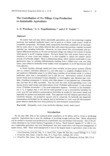The Contribution of No-Tillage Crop Production to Sustainable Agriculture
JIRCAS international symposium series
| ISSN | 13406108 |
|---|---|
| 書誌レコードID(総合目録DB) | AA1100908X |

本文フルテキスト
intlsymp-4_57-64.pdf324.91 KB
No matter how one may define sustainable agriculture, use of soil-conserving cropping practices, less synthetic herbicide inputs, and as good as or better weed control would be compatible components. Previously, these components have been considered to be incompatible by some, since it was widely believed that soil-conserving practices required increased pesticide use, including herbicides. However, we have shown that environmental and ecological differences between no-till and conventional tillage can enhance the control of certain weed species in no-till cropping systems. We have shown that with proper choice and manipulation of cover crops and residues, it is often possible to reduce the number and/or amount of-herbicides needed. Thus, in eliminating tillage, which restricts weed seeds to poor germination sites, by utilizing allelochemicals leaching from a killed cover crop, and using newer, more effective herbicides when needed, weed management in no-till has become much more effective.
In North Carolina, although results have been variable, we have grown soybean (Glycine
Max L.), tobacco (Nicotiana tabacum L.), com (Zea mays L.), sorghum (Sorghum bicolor L.), and sunflower (Helianthus annus L.) in killed heavy mulches of rye (Secale cereal L.) without herbicides, other than a non-selective one to kill the rye. Early-season control of broadleaved weeds such as sicklepod (Cassia obtusifolia L.) morningglory spp. (Ipomoea spp.) cocklebur (Xanthium strumarium L.) prickly sida (Sida spinose L.) and pigweed spp. (Amaranthus spp.) has been 80 to 90% successful. Rye has been the most weed-suppressing cover crop among several small grains and subterranean clover (Trifolium subterraneum L.) and crimson clover (Trifolium incamatum L.) the most suppressive legumes. Currently in the Southeastern U. S., it appears that it will still be most practical to use a non-selective herbicide for cover crop kill and selective postemergence herbicides as needed for late-season weeds and especially for grasses and perennial weeds. This approach will still enhance agricultural sustainability because; (a) productive top-soil will be conserved, (b) herbicide use (especially preemergence herbicides) can be reduced, and (c) herbicides for cover crop kill and postemergence selective herbicides have little potential for environmental contamination.
In North Carolina, although results have been variable, we have grown soybean (Glycine
Max L.), tobacco (Nicotiana tabacum L.), com (Zea mays L.), sorghum (Sorghum bicolor L.), and sunflower (Helianthus annus L.) in killed heavy mulches of rye (Secale cereal L.) without herbicides, other than a non-selective one to kill the rye. Early-season control of broadleaved weeds such as sicklepod (Cassia obtusifolia L.) morningglory spp. (Ipomoea spp.) cocklebur (Xanthium strumarium L.) prickly sida (Sida spinose L.) and pigweed spp. (Amaranthus spp.) has been 80 to 90% successful. Rye has been the most weed-suppressing cover crop among several small grains and subterranean clover (Trifolium subterraneum L.) and crimson clover (Trifolium incamatum L.) the most suppressive legumes. Currently in the Southeastern U. S., it appears that it will still be most practical to use a non-selective herbicide for cover crop kill and selective postemergence herbicides as needed for late-season weeds and especially for grasses and perennial weeds. This approach will still enhance agricultural sustainability because; (a) productive top-soil will be conserved, (b) herbicide use (especially preemergence herbicides) can be reduced, and (c) herbicides for cover crop kill and postemergence selective herbicides have little potential for environmental contamination.
| 作成者 | A. D. Worsham G. G. Nagabhushana J.P. Yenish |
|---|---|
| 著者キーワード | allelopathy cover crops herbicide reduction mulch weed control |
| 公開者 | Japan International Research Center for Agricultural Sciences |
| オンライン掲載日 | |
| 号 | 4 |
| 開始ページ | 57 |
| 終了ページ | 64 |
| 言語 | eng |
